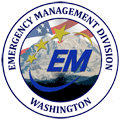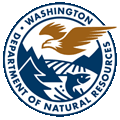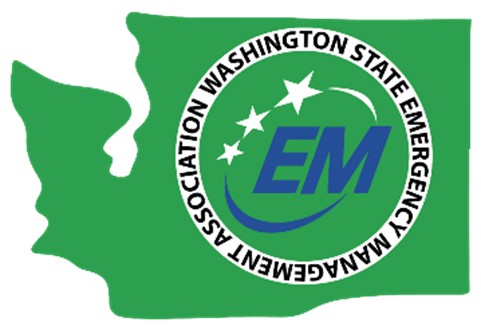- ▾ Other ShakeOuts ▾
- Alaska
- American Samoa
- Arizona
- British Columbia
- California
- Central U.S. (AL AR IA IL IN KS KY LA MO MS NE OH OK TN)
- CNMI
- Colorado
- Guam
- Hawaii
- Idaho
- Japan
- Montana
- Nevada
- New Mexico
- New Zealand
- NorthEast U.S. (CT MA ME NH NJ NY PA RI VT)
- Oregon
- Puerto Rico
- Quebec & Eastern Ontario
- SouthEast U.S. (DC DE FL GA MD NC SC VA WV)
- Texas
- Upper MidWest U.S. (MI MN ND SD WI)
- U.S. Virgin Islands
- Utah
- Washington State
- Wyoming
- Yukon
- Other Countries

Why Should You Participate?
While earthquake hazard varies from region to region (see below), most of Washington is prone to earthquakes. You could be anywhere when an earthquake strikes: at home, at work, at school or even on vacation.
What we do now will determine our quality of life after our next big earthquake. Are you prepared to survive and recover quickly?
The Great Washington ShakeOut is a statewide opportunity to practice how to be safer during big earthquakes: "Drop, Cover and Hold On." The ShakeOut has also been organized to encourage you, your community, your school, or your organization to review and update emergency preparedness plans and supplies, and to secure your space in order to prevent damage and injuries.
Learn more below, or read answers to frequently asked questions.
Benefits
Register today so that you or your organization will:
- Be counted in the largest-ever earthquake drill in Washington!
- Be listed with other participants in your area (Optional)
- Be an example that motivates others to participate & prepare
- Be updated with ShakeOut news and preparedness tips
- Have peace of mind that you, your family, your co-workers and millions of others will be better prepared to survive and recover quickly from our next big earthquake!
EARTHQUAKE AND TSUNAMI HAZARDS
Overview
The Pacific Coast of Washington is at risk from tsunamis. These destructive waves can be caused by coastal or submarine landslides or volcanism, but they are most commonly caused by large submarine earthquakes.
Tsunamis are generated when these geologic events cause large, rapid movements in the sea floor that displace the water column above. That swift change creates a series of high-energy waves that radiate outward like pond ripples. Offshore tsunamis would strike the adjacent shorelines within minutes and also cross the ocean at speeds as great as 600 miles per hour to strike distant shores. In 1946, a tsunami was initiated by an earthquake in the Aleutian Islands of Alaska; in less than 5 hours, it reached Hawaii with waves as high as 55 feet and killed 173 people.
Tsunami waves can continue for hours. The first wave can be followed by others a few minutes or a few hours later, and the later waves are commonly larger.
Washington Emergency Management Tsunami Program
The earthquake threat in Washington is not uniform. While most earthquakes occur in Western Washington, some damaging events, such as the 1872 magnitude 6.8 (est.) quake, do occur east of the Cascades. Geologic evidence documents prehistoric magnitude 8 to 9.5 earthquakes along the outer coast, and events of magnitude 7 or greater along shallow crustal faults in the urban areas of Puget Sound.
Washington’s earthquake hazards reflect its tectonic setting. The Pacific Northwest is at a convergent continental margin, the collision boundary between two tectonic plates of the earth’s crust. The Cascadia subduction zone, the fault boundary between the North America plate and the Juan de Fuca plate, lies offshore from northern California to southern British Columbia. The two plates are converging at a rate of about 2 inches per year. In addition, the northward-moving Pacific plate is pushing the Juan de Fuca plate north, causing complex seismic strain to accumulate. The abrupt release of this slowly accumulated strain causes earthquakes.
Earthquakes at Washington Military Department Emergency Management Division.
In Washington, earthquakes and landslides are the most likely sources of a tsunami.
The Pacific Rim countries have a history of damaging tsunamis caused by both distant and local earthquakes. Earthquakes have caused 98% of the world’s tsunamis with over 73% of these being observed along the Pacific “Ring of Fire”. For this reason, communities in low-lying coastal areas around the Pacific Rim are among the most at risk to tsunami damages generated from both local and distant sources that can strike within minutes to many hours.
Washington State Earthquake Scenario Catalog (Washington State Department of Natural Resources)
DNR Interactive Geology Portal (Washington State Department of Natural Resources)
The Seattle Fault - Beneath Largest City in the Pacific Northwest (2 minute Geology, from HUGEfloods.com Youtube Channel)
Tsunami inundation maps (Washington State Department of Natural Resources)
Tsunami Evacuation Maps (Washington State Department of Natural Resources)
Recent Earthquakes Map (Pacific Northwest Seismic Network)
Earthquakes in Washington (United States Geological Survey)
Why Drop, Cover, and Hold On?
Why is it important to do a Drop, Cover, and Hold On drill? To react quickly you must practice often. You may only have seconds to protect yourself in an earthquake, before strong shaking knocks you down--or drops something on you. Practicing helps you be ready to respond.
- If you are inside a building, move no more than a few steps, then Drop, Cover and Hold On:
- DROP to the ground (before the earthquake drops you!),
- Take COVER by getting under a sturdy desk or table, and
- HOLD ON to it until the shaking stops.
- If you in a low lying coastal area, immediately move inland and to higher ground because a tsunami could follow the earthquake. Do not return until local officials announce it is safe to reenter coastal areas.
- If you are outdoors when the shaking starts, you should find a clear spot away from buildings, trees, streetlights, and power lines, then Drop, Cover and Hold On. Stay there until the shaking stops.
- If you are driving, pull over to a clear location, stop and stay there with your seatbelt fastened until the shaking stops. Once the shaking stops, proceed with caution and avoid bridges or ramps that might have been damaged.
Ground shaking during an earthquake is seldom the cause of injury. Most earthquake-related injuries and deaths are caused by collapsing walls and roofs, flying glass and falling objects. It is extremely important for a person to move as little as possible to reach the place of safety he or she has identified because most injuries occur when people try to move more than a short distance during the shaking.
Look around you now, before an earthquake. Identify safe places such as under a sturdy piece of furniture or against an interior wall in your home, office or school so that when the shaking starts you can respond quickly. An immediate response to move to the safe place can save lives. And that safe place should be within a few steps to avoid injury from flying debris.
Further information:







